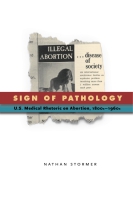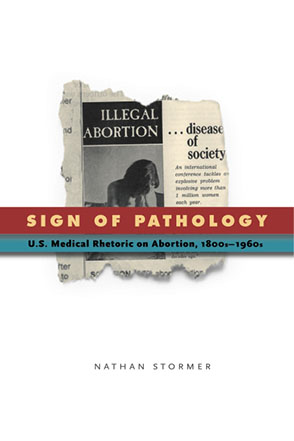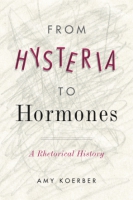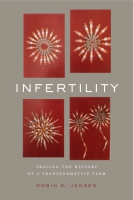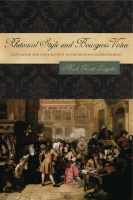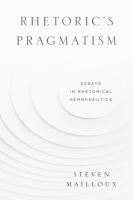Sign of Pathology
U.S. Medical Rhetoric on Abortion, 1800s–1960s
Nathan Stormer
“In Sign of Pathology, Nathan Stormer provides an original genealogical reading of the U.S. medical profession’s public discourses about abortion in the nineteenth and early twentieth centuries. Anyone who appreciates Foucauldian perspectives should find admirable Stormer’s precisely developed argument that these medical discourses ‘made the chaotic material conditions of abortion’s morbidity rhetorically capacious for biopolitics.’”
- Description
- Reviews
- Bio
- Table of Contents
- Sample Chapters
- Subjects
Often framed as an argument over a right to choose versus a right to life, our current understanding of this conflict is as a contest over who has the better position on reproductive biology. Against this view, Sign of Pathology argues that, as it became a medical problem, abortion also became a template, more generally, for struggling with how to live—far exceeding discussions of the merits of providing abortions or how to care for patients. Abortion practices (and all the legal, moral, and ideological entanglements thereof) have rested firmly at the center of debate over many fundamental institutions and concepts—namely, the individual, the family, the state, human rights, and, indeed, the human. Medical rhetoric, then, was decisive in cultivating abortion as a mode of cultural critique, even weaponizing it for discursive conflict on these important subjects, although the goal of the medical practice of abortion has never been to establish this kind of struggle. Stormer argues that the medical discourse of abortion physicians transformed the state of abortion into an indicator that the culture was ill, attacking itself during and through pregnancy in a wrongheaded attempt to cope with reproduction.
“In Sign of Pathology, Nathan Stormer provides an original genealogical reading of the U.S. medical profession’s public discourses about abortion in the nineteenth and early twentieth centuries. Anyone who appreciates Foucauldian perspectives should find admirable Stormer’s precisely developed argument that these medical discourses ‘made the chaotic material conditions of abortion’s morbidity rhetorically capacious for biopolitics.’”
“Nathan Stormer has written a stunning book, beautifully illustrating how rhetorical struggles over and through abortion have long been about situating ourselves—and pregnant women—in time and place. Civilization is recursive to the maternal body, with abortion positioned as a sign of collective disorder. It is precisely because abortion is a medicalized national metric that the issue is so intractable. Defined through biopolitics, abortion is perceived as a collective, irreparable wound, and ongoing political struggles reliant on familiar frameworks only deepen this intractability. Stormer’s elegant genealogy, both diagnostic and gently prognostic, has the capacity to shift how we see human reproduction and our place in it.”
“If your primary scholarship is in abortion rhetorics or historic American medical rhetorics, then this text is an indispensable and invaluable contribution to your area. Similarly, for those interested in rhetorical genealogy and/or rhetorical historiography, broadly conceived, Signs of Pathology is an exemplar text in the genre.”
Nathan Stormer is Mark and Marcia Bailey Professor of Communication and Journalism at the University of Maine.
Contents
Acknowledgments
Introduction: Struggling Through Life
Part 1
1. When Abortion Became a Political-Economic Problem
2. Remembering, Forgetting, and the Secrets of Life
Part 2
3. “White Man’s Plague”: Anti-Malthusian Memory Work at the Fin de Siècle
4. “More Wisdom in Living”: Neo-Malthusian Memory Work at Midcentury
5. “The Lesser of Threatened Evils”: Therapeutic Amnesias
Conclusion: Seeking Immunity
Notes
Bibliography
Index
Introduction
Struggling Through Life
Official discussions about reproductive politics have rarely been women-centered. More often than not, debate and discussion about reproductive politics—where the power to manage women’s reproductive capacity should reside—have been part of discussions about how to solve certain large social problems facing the country. These social or economic or political problems have changed over time. And the fertility of different groups of women has been associated with solutions to different problems. But across time, the social-problem approach for female fertility has prevailed.
—Rickie Solinger, Pregnancy and Power
<end epi>
Abortion became a public problem in the United States during the antebellum era, and it has been a site of struggle ever since. It has been an enduring pathway for conflict and a critical vector for exerting pressure on ways of living. Rhetoric about abortion is, therefore, not only about fighting over the practice, but also about fighting through it, making it a thing by which and for which there is struggle. This subtle difference in language expresses a significant difference in outlook. The fighting over perspective focuses on near-term goals and assumes that the issues contested via abortion, such as the limits of women’s self-determination, can be addressed to some degree by the right policy or the right normative structures. This perspective is primarily concerned with the immediate act of ending a pregnancy, as well as the knowledge and decision-making authority involved with this act. Within this solution-oriented mentality, conflict tends to be defined by success in achieving specific goals. The current antiabortion strategy of raising barriers to access is a good example. Winning the contest to restrict access is seen as a partial solution to the perceived evils of abortion.
By contrast, the fighting through perspective explored in this book shifts attention away from battles won and lost and instead emphasizes the conditions upon which struggle continues. I am concerned with what makes it possible for abortion to function as a medium of power: the fact that practices for ending pregnancies (and all the legal, moral, and ideological entanglements thereof) rest firmly at the center of debate over many fundamental institutions and concepts, namely, the individual, the family, the state, human rights, and indeed, the human. Certainly the health and well-being of women is at stake in abortion’s regulation and the fate of unborn embryos as well, but more broadly so are relations between genders, classes, races, immigrants, citizens, and religions. The family’s purpose in regard to the state is also central to the regulation of abortion. Population growth is clearly linked to abortion practices and with it all the problems of too many people. Poverty, pollution, economic power, and climate change can all be implicated in interrupting pregnancy through its impact on population. For a disturbing portion of the public, too few of certain kinds of people make abortion a different kind of population problem relative to cultural/ethnic superiority. Conflict flows continually through women’s bodies when modes of power adopt “life” (expansively construed) as the mechanism for shaping the conduct of whole peoples. If, when, and how pregnancies can be ended become critical skirmish points for efforts to remake how people live.
We need to examine how we fight through, not just over, abortion, and the significance of interrupting pregnancy in medical rhetoric is a crucial dimension of how we struggle. Discussion of post-Roe pro-life and pro-choice advocacy usually alights on emotional, rational, ideological, and aesthetic tools and strategies but takes the medicalization of abortion’s harm for granted. A potent assumption that persuasive words and images about abortion could solve something lingers in the background of such discussions, that we are trying to move toward or should be moving toward some kind of resolution of the conflict. With the right words, the right appeals, the right reasons presumably some sort of working consensus could be had, even if temporarily. The unspoken understanding is that rhetoric about abortion seeks and is capable of closure, or at least of putting key issues to bed. This assumes that determining what abortion is and does to people and to communities is essentially a factual disagreement that can be refereed by experts. Recognizing this some years ago, I began investigating the history of medical rhetoric on abortion. How had experts come to understand abortion’s danger in the first place? When did disagreement over the consequences of abortion begin? Had there been consensus before? What had happened?
These were my initial questions and they lead to the nineteenth century because it was physicians of that era who initially treated abortion as a disease that enervates society. A standard, thumbnail narrative about abortion’s appearance on the U.S. national scene matches the perspective of a fight over the advisability of intentionally terminating pregnancies and begins with physicians’ efforts to criminalize the practice. In the antebellum United States, most people did not believe that ending a pregnancy before quickening was wrong. Quickening is the ancient doctrine enshrined in English common law that life begins at first fetal movement, usually between fifteen and twenty weeks. Northeastern doctors, most notably Horatio Robinson Storer of Boston, took the lead in changing that view. In 1859, after nearly two decades of mounting evidence that women were ending pregnancies in greater numbers, the new, professionally weak American Medical Association staged a medical campaign against the practice, spearheaded by Storer and like-minded colleagues. Exhibiting a diverse range of fears and aspirations, physicians combined political advocacy and public condemnation, echoed by some religious leaders and newspapers, to make abortion a public scandal. Most states criminalized abortion by the 1870s and the federal Comstock Law of 1873 censored salacious materials and licensed seizure of literature and items related to fertility control sent by mail. Whereas in 1809 the “Massachusetts State Supreme Court dismissed an indictment for abortion because the prosecution had not reliably proved that the woman was ‘quick with child,’” by century’s end all states had criminalized the practice from conception onward. The U.S. abortion underground was born.
Rather quickly, however, it became pointless to follow this tidy version of the story to find the bases of factual dispute because such inquiry is premised on abortion’s being something we fight over. The relative harm from terminated pregnancies was always contested, but contestation was a function of abortion’s serving a rhetorical purpose as the symptom of something else, a means to leverage broader struggles, not a result of shifting knowledge over which disagreement percolated. I found a relentless connection of abortion to world historical place-in-time, which lead me to question why abortion presented physicians with a problem of emplacement, or rather displacement from a better future we should already be occupying, and how fundamental struggles about power and order were refracted through the practice. This is not easy to explain but it does suggest that a resolution of differences about induced abortion’s risks to individuals and communities is improbable because abortion is not an issue that can be concluded. History does not lead to some prior medical consensus (there was none) or even to the sense that consensus could be achieved (there never has been consensus). Because abortion, from ancient times to the contemporary world, is an ever-present activity that is intimately connected to the values, organization, and structure of societies, to find some consensus on its legitimacy would mean finding consensus on an extraordinary range of other issues. The same might be said for birth control except that abortion involves the termination of pregnancy, not its prevention, and if done improperly or by unskilled hands, can be quite dangerous. The morbidity and risk associated with abortion and the fact of ending a pregnancy are materially different from contraception.
Since my initial finding that abortion existed in medicine not as a dispute awaiting resolution but rather as way of orienting struggle around new ways of living, my research has been about how the material aspects of induced abortion function within medical discourse about it, particularly how abortion has been constituted as a problem by virtue of its morbidity and how its consequences are put to use broadly to contest ways of life. I have put aside the understanding of rhetoric as argument because, as a paradigm, it is incapable of explaining the way abortion practices and consequences serve as a conduit of contestation (as opposed to a topic to be debated). To couch the rhetoric of abortion in terms of public argument shoehorns its material aspects into a confining model of discourse, dissoi logoi, which is the concept of disputation derived from ancient Greek philosophy as a match between two sides. It is a system that imagines opposing forces linked together through limited, specific concepts of communicative action within the public sphere; the ligature that produces clash between these forces, the point of connection that simultaneously divides them, is the process of civic and cultural dispute. Abortion in the United States today is a quintessential example of rhetoric as wrangling, or twofold discourse, to the point of demonstrating the futility of such rhetoric, for not even the most carefully crafted entreaties of the opposing sides seem capable of resolving the controversy, or even of satisfactorily defining the problem. Further, abortion can seem like an isolated disagreement, but this misleading view is a function of contemporary American politics that treats it as a “wedge issue” or a “special interest” concern. As an explanation for abortion conflicts, dissoi logoi can do little more than describe it as “intractable.”
Against this paradigm, I have found abortion practices and consequences to be rhetorically “weaponized,” that is, made into a mechanism of struggle, by their medicalization. Specifically, medical experts constituted the occurrence and possible harm of abortion as a sign of pathology, by which I mean a measure of an afflicted society, one that threatens itself by interfering with pregnancy because of cultural stresses, limitations, and negative influences. Physicians made the state of affairs regarding abortion into a diagnostic that could situate a community in time and evaluate its overall progress. More broadly, they made it possible to use abortion as a means of inhabiting time. We know “where” and “when” we are based on how common and dangerous the practice is. Are we civilized or not? Are we advancing and sliding backward? Since the nineteenth century, the state of abortion can tell us, because now it signals if a community is generally doing well, given that its practice implicates institutional and cultural foundations. However, abortion as a sign of pathology became useful for more than judging the wisdom of present ways of life, and that is the key to its becoming a medium for contestation; a diagnostic of the contemporary moment is a modality for exerting power. Conflicts over how to live can be mounted based on the pathological indications of abortion. We know we need to live differently because they occur, so based on why and how they occur, we can surmise what needs fixing. As a bellwether, abortion came to operate as something like infant mortality rates but differently tangled up in power relations.
To account for the ways in which ending pregnancy became a charter of who we are as a people, whether we are improving or getting worse, and how we might live differently, I analyze how indefinite conflict is sustained through the trauma linked to the practice. Hence, this book is intended to reposition one’s sense of rhetoric about abortion, not to flatter it, by directing attention to the conviction that abortion is evidence of something wrong with the world, perhaps the least considered aspect of the rhetoric. In the process, I demonstrate something more fundamental: abortion, as a broad indicator of problems, has become a way to inhabit the present as a moment of risk. The privileged mode for this is to treat abortion as a sign of pathology and so it is important to attend to the crucible in which this mode was fashioned, professional medicine. Recognizing that abortion has been conceived as a measure of collective disorder and locating its germinal site is one thing; explaining why that matters is another and requires an unorthodox perspective on rhetoric.
By unorthodox, I allude to a capacity to produce memories as a core feature of rhetoric. Not memory as understood by the scholarly “tradition of inwardness,” namely, studies of personal or cognitive memory, and not memory as understood by collective, social, or public recognition of the past, but memory understood as orientation in time and place. Once abortion as a practice tells us something definitive about the wisdom or rightness of our ways of life, we can use it to remind ourselves how far we have come or how far we have fallen. The extent and danger of abortion become recursive, by which I mean a recurrent phenomenon that act as a touchstone for memory work. Analyzing the recursive value of terminated pregnancies makes it possible to understand abortion’s intractability not as a bug in the rhetoric but as a medicalized feature. The fact that abortion is ever present, but that its numbers and risks change depending on the conditions of its practice, offers the possibility of reconstructing what those conditions are or have been at any point in time. Fighting through abortion depends on this recursive capacity for recollection because it is impossible to position and evaluate the present by virtue of abortion without it. Functionally, abortion’s material aspects make it possible to plot the trajectory of the present moment as part of opening and waging conflicts that can alter that trajectory and that often range beyond the practice itself. Only by attending to the persistent pathologization of induced abortion does the capacity for memory work undergirding incessant struggle become visible—not by attending to the persistent wrangling over its specific harms that follow from its being pathological.
Physicians did not avail themselves of any precise theory of pathology when discussing induced abortion because it is not strictly a physiological problem. They used available pathological models to discuss patients’ somatic troubles, but the practice of abortion was itself a social problem expressed through physiological consequences. Nonetheless, physicians used the concept of sickness in ways broadly consistent with Georges Canguilhem’s findings in his history The Normal and the Pathological. Reviewing modern theories of pathology, Canguilhem argued that “diseases are new ways of life” that are sensed as discomforting or harmful. By “way of life,” he meant that disease is a relative concept embodied within humans’ experience of “their relations with the whole of their environment,” corporeal and cultural. “To be sick means that a man [sic] really lives another life, even in the biological sense of the word.” Pathology is thus not a measurable divergence from normal health but a qualitative evaluation that a different way of existing is negative or undesirable. Disease is not the absence of health so much as “another norm but one which is, comparatively speaking, pushed aside by life.” Or, sickness is “the feeling of life gone wrong,” which is the sense that physicians used when describing induced abortion as pathological.
The relational quality of “life gone wrong” is the condition for illness to function as a kind of signal: “pathogenic stimuli or agents are never received by the organism as brute physical facts, but are lived by the consciousness as signs of tasks or tests” that result from immersion in a lived environment. Canguilhem points out that paradoxically it is the signs of pathology that produce concepts of the normal and the healthy. In other words, visions of normal, healthy ways of life are memory projects that have “recourse to disease as the only touchstone.” A normative view of life involves remembering the loss of health relative to future well-being; hence, it is the “nature of the normative that its beginning lies in its infraction.” In the abstract, the logic is straightforward: the promise of a different, healthier future depends on a normative judgment that the present state of things is afflicted in some way. “Now” is located temporally and spatially through the memory of disease. This requirement to place the present in order to judge the present as disordered is obligatory in the “social-problem” approach to fertility that Rickie Solinger describes in the epigraph to this chapter. When induced abortion becomes a public problem it brings with it the corresponding rhetorical problem of needing memory-related practices sufficient to place the current state of affairs as getting worse, or at least not improving.
Matters become complicated when you focus not just on the hazards of extant means of ending unwanted pregnancy but also on the details of how these practices participated in memory work. There was no special recollective medical practice that materialized a sense of place, no moment when physicians said, “We must position the contemporary world as failing in order to ground our calls for change.” There neither is nor was a genre of discourse consciously devoted to remembering public health threats; medical experts did not principally turn to memoirs, commemorations, or reminiscences to build a case for action. Rather, patients became cases, cases became data series, and series became vital statistics.
In this book, I follow the descent of abortion as pathognomonic—that is, as a sign of pathology—from its emergence in medical discourse of the mid-1800s up to the 1960s, tracking the unintended memory work inherent to physicians’ professional discourse. This is a tightly limited study because I am concerned with a particular rhetorical functionality relative to abortion practice. I deal exclusively with abortion’s career as a sign of pathology, not with abortion in medicine generally, modern discussion and disagreement about which extends back into the eighteenth century. I also limit my study to the United States for practical reasons; a cross-cultural analysis would be too sprawling given the fine-grained analysis I have in mind. Along the way, I will wend through the discourse of anti-Malthusians, who opposed small families, and who saw in abortion an indicator of collective moral amnesia, to the emergence of a counterdiscourse among neo-Malthusians, favoring small families, who relied on the same pathognomonic logic to find in abortion unscientific, retrograde society. Although the same recursive dynamic is active today, it has changed since the mid-1960s. The decline in maternal mortality and the rise of the fetology introduced critical differences too complex to address in this work, so I will leave off my investigation at the moment when protection for unborn bodies displaced protection of women’s bodies as a primary touchstone of medical discourse on abortion.
Mailing List
Subscribe to our mailing list and be notified about new titles, journals and catalogs.
